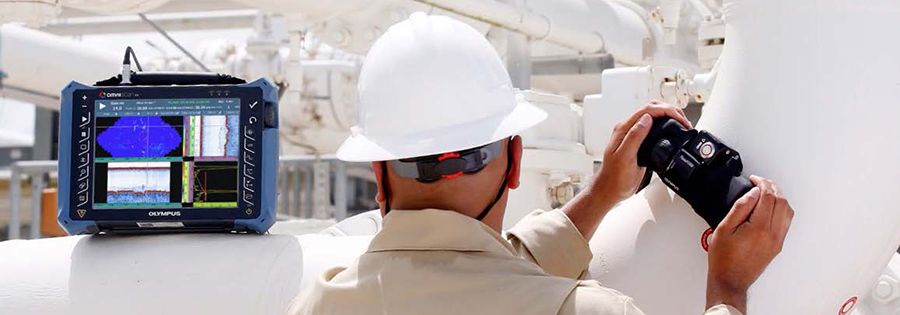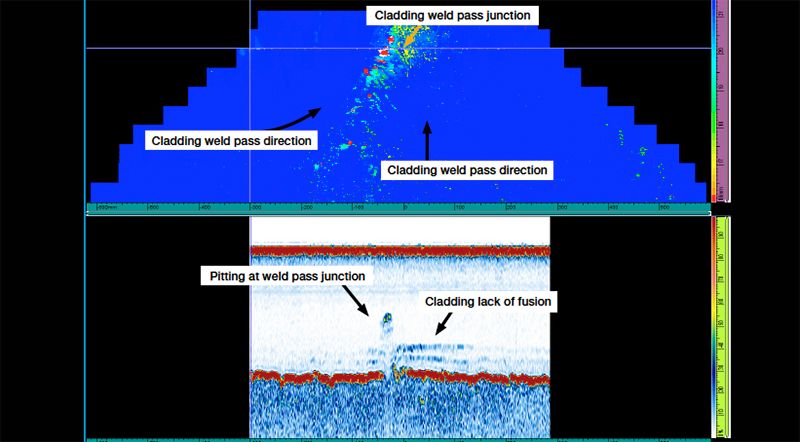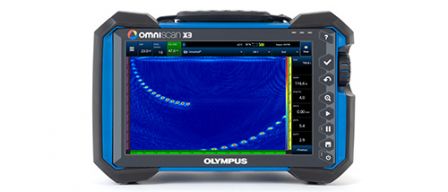Advantages and Disadvantages of Phased Array Inspection of Pipe Elbows
Phased array (PA) technology can provide inspectors with several advantageous features, such as high-resolution data, high-quality imaging, and excellent coverage. When PA instruments are used to inspect a pipeline, inspectors often see an improvement in their productivity as the imaging PA provides is easier for them to interpret, the probability of detection is high, and the results are less operator dependent. These advantages hadn’t been fully realized for pipe elbow inspection primarily due to physical constraints. The changes in surface shape from concave on the intrados to convex on the extrados as well as the wide range of diameters that need to be covered are particularly challenging with existing phased array equipment. Because large, rigid phased array probes are unsuited for inspecting the curves of pipe elbows, inspectors opt to use small conventional UT transducers to perform spot checks, which involves drawing a grid on the pipe and noting the results box by box. There are several downsides to this method: it is slow and tedious, highly operator-dependent, and the inspectors are deprived of the easy-to-read imaging offered by phased array technology.

Corrosion mapping of pipe elbows using conventional UT small-footprint transducers
Challenges of Inspecting Clad Pipe Elbows with Radiology
To protect pipes transporting corrosive liquids, the interior of the pipe can be coated with a corrosion-resistant material. For example, carbon steel pipes are often clad with a metal such as a nickel-based alloy. Clad pipes are susceptible to pitting corrosion and delamination, so regular inspection is critical. In addition to conventional UT inspection, a typical method used to inspect clad pipes is radiography. However, there are several drawbacks associated with inspecting pipe elbows with radiography. First, the pipeline flow must be stopped, the pipe emptied, and the elbow removed and sent off-site for radiography inspection. Second, the process takes about a day and a half, so it is inefficient timewise and, therefore, costly. Third, it presents some risks to operators as the pipe elbows are usually located high off the ground, are very heavy, and the contents are hazardous to handle.
Phased Array Solution Using the FlexoFORM Pipe Elbow Scanner
To help resolve the inherent issues of clad pipe elbow inspection, Olympus has developed a flexible ultrasonic phased array probe and scanner for pipe elbows—the FlexoFORM solution. This innovative probe and scanner solution can provide high-resolution thickness mapping of the entire pipe elbow, making it easier for inspectors to make an accurate diagnosis. With the precise information provided by the FlexoFORM scanner, inspectors can quickly and reliably evaluate the pipe elbow’s remaining operational life and determine the repair or maintenance requirements.
The FlexoFORM solution is comprised of three components: a flexible phased array probe, local-immersion water wedges (for a wide range of pipe diameters), and a scanner that provides stability and positioning information in relation to the part’s surface.
FlexoFORM Solution Components
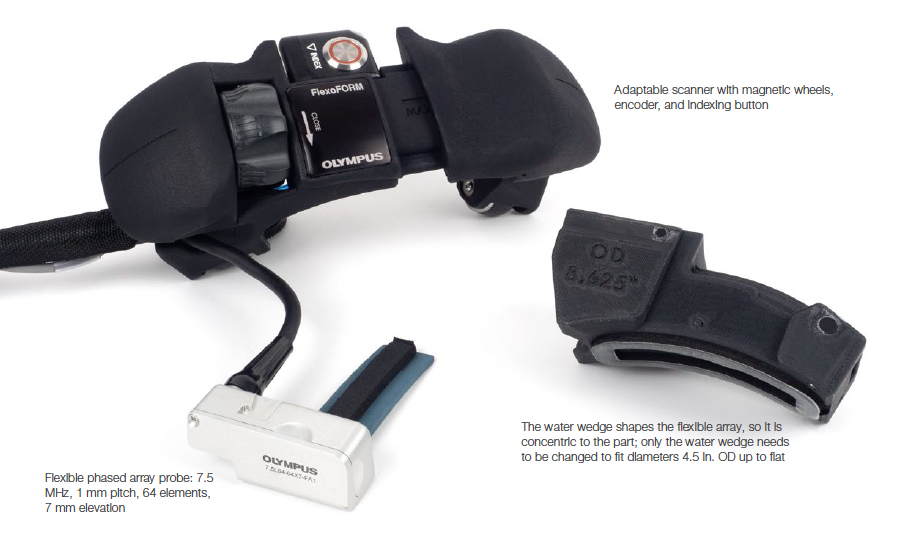
Results of Corrosion Pitting and Delamination Tests on a Clad Pipe Elbow
Using the FlexoFORM solution, a complete scan of a clad pipe elbow can be completed on-site in a fraction of the time of the radiology method, which can take more than a day to complete. For the tests that Olympus conducted, the pipe elbow scan could have been performed while the line was still in operation, reducing not only the time but also operational costs. It also mitigates the safety issues related to removing the elbow from the line and sending it to the radiography bunker.
The test specimen in this case was a carbon steel pipe with an internal layer of welded nickel cladding. The pipe elbow had an outer diameter of 16 in. and was 23 mm thick. The resolution provided by the FlexoFORM scanner was 1 × 2 mm, with a beam aperture of 4 elements.
Including preparation time, the entire elbow was inspected in 35 minutes.
To demonstrate the clarity and precision of the results provided by the FlexoFORM scanner, we made a comparison using a sample taken out of production. The section was cut in half lengthwise, enabling us to see the cladding weld passes as well as the corrosion pitting occurring at a junction between two weld patterns. The C-scan and B-scan displays on the OmniScan® instrument show how the high-resolution imaging provided by phased array technology can make interpreting and diagnosing easy for inspectors. The pitting corrosion and lack of fusion of the cladding are easier to identify. The junction where weld cladding passes meet can be flagged as susceptible to pitting, especially when there is a lack of fusion between the cladding and the base material. This knowledge enables the inspector to better estimate the remaining life of the pipe elbow and optimize the inspection schedule. | 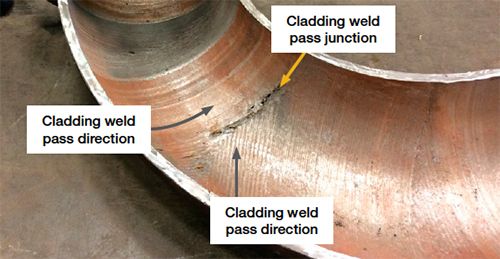 Corrosion pitting occurring at the junction between cladding weld passes |
Summary of the Advantages Offered by the FlexoFORM Scanner Solution
The FlexoFORM phased array solution can help inspectors checking for clad pipe corrosion pitting and delamination overcome some of the challenges of pipe elbow inspection. The scan of the entire elbow can be completed on-site, without needing to take the pipe out of service. The flexible phased array probe enables inspectors to benefit from the advanced, high-resolution imaging provided by phased array, and the scanner’s encoder gives them the ability to map the thickness of the entire pipe elbow. The solution is cost-effective, easy to use, and can be applied to a broad range of diameters.
